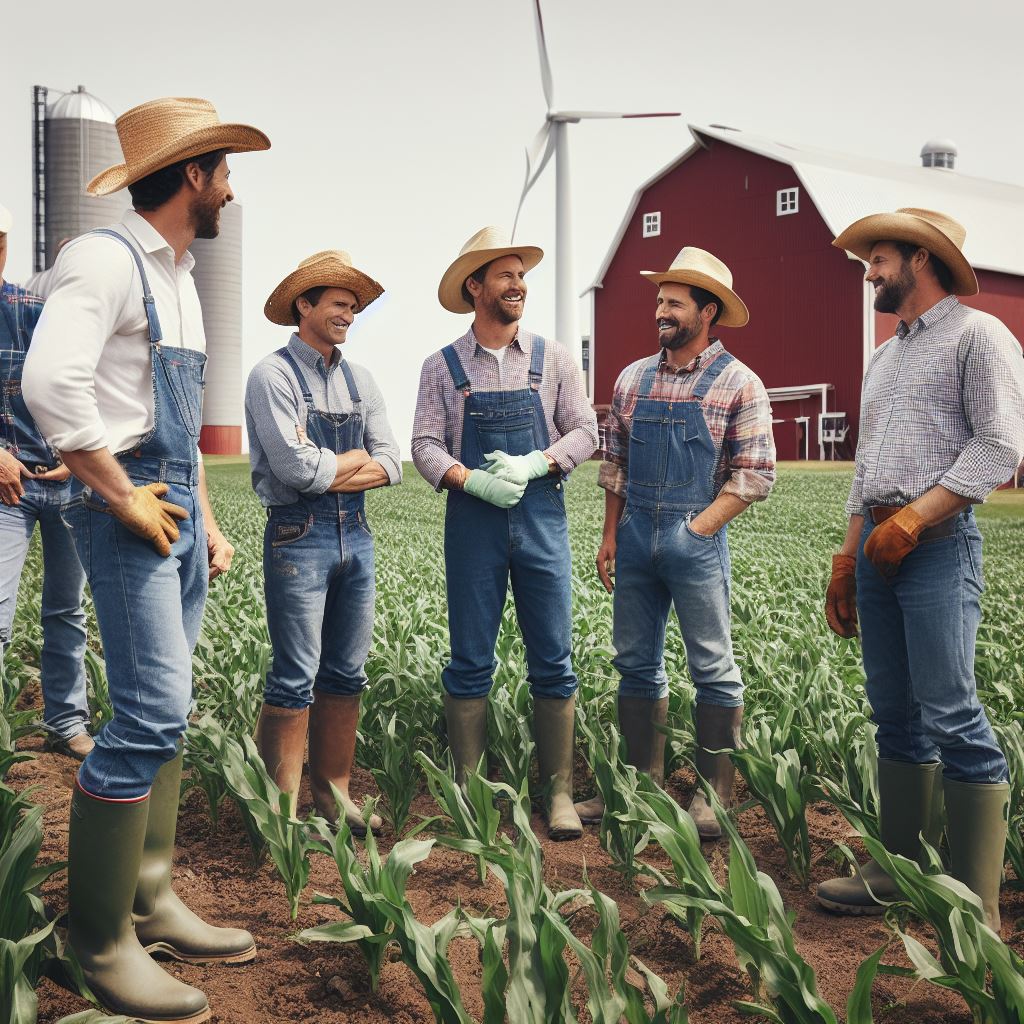Introduction
Farming subsidies in Japan provide financial assistance to farmers to support agricultural production.
It is crucial to regularly update and revise farming subsidy policies to ensure their effectiveness.
Against the backdrop of shifting global paradigms in agriculture, the intricacies of farming subsidies in Japan warrant meticulous examination.
As we embark on this exploration, the 2024 update delves into the multifaceted dimensions of Japan’s agricultural subsidy landscape.
Beyond the fiscal aspects, we unravel the socio-economic implications, environmental considerations, and the intricate web of trade relations that these subsidies intricately influence.
The purpose of this blog post is to discuss the latest update on farming subsidies in Japan and their implications.
In a world grappling with sustainability challenges, understanding how Japan navigates its agricultural support mechanisms becomes pivotal, shaping not only its domestic food security but also its position in the international agricultural arena.
Join us on this insightful journey into the heart of Japan’s farming subsidies, where policies converge with global dynamics to sculpt the future of its agricultural resilience.
Historical Background of Farming Subsidies in Japan
Brief history of farming subsidies in Japan
Government-led farming subsidies in Japan dates back several decades.
Initially implemented to stabilize food production and support rural communities.
Early subsidies focused on improving infrastructure, promoting modern farming techniques, and increasing productivity.
Subsidies played a crucial role in helping Japan become self-sufficient in agriculture.
In the 1970s, subsidies were expanded to address environmental and quality control concerns.
Previous updates in farming subsidy policies
- During the 1980s, subsidies were adjusted to shift emphasis towards income support for farmers.
- Farmers faced challenges due to globalization, trade liberalization, and urban migration.
- Support measures introduced to counter adverse effects of market fluctuations on agricultural incomes.
- Efforts were made to enhance rural employment opportunities and promote regional development.
- The 1990s saw an increased focus on sustainable farming practices and organic agriculture.
Impact of past policies on the agriculture sector
Farming subsidies played a crucial role in maintaining stable food supply and supporting rural communities.
Increased productivity through technological advancements boosted agricultural output.
Transform Your Agribusiness
Unlock your farm's potential with expert advice tailored to your needs. Get actionable steps that drive real results.
Get StartedThe income support provided stability to farmers, encouraging them to continue farming.
Subsidies helped preserve traditional farming practices and maintain cultural landscapes.
However, challenges such as aging farming population and land consolidation persisted.
Government policies evolved to address modern challenges and promote innovation in agriculture.
The historical background of farming subsidies in Japan showcases the government’s commitment to supporting its agricultural sector.
Over the years, subsidies have undergone various updates to address changing circumstances and challenges faced by farmers.
Initially, the focus was on infrastructure development and productivity improvement. This led to Japan achieving self-sufficiency in agriculture.
In later years, the policies shifted towards income support for farmers, considering the impacts of globalization, trade liberalization, and urban migration.
Subsidies played a crucial role in stabilizing agricultural incomes, encouraging farmers to continue their agricultural activities.
The support measures also aimed to enhance rural employment opportunities and promote regional development.
As the 1990s approached, the emphasis expanded to sustainable farming practices and organic agriculture, reflecting environmental and consumer concerns.
The subsidies helped promote eco-friendly farming methods and maintain the ecological balance.
Overall, farming subsidies have had a positive impact on the agriculture sector in Japan.
They have ensured stable food supply, supported rural communities, and preserved traditional farming practices.
However, challenges such as an aging farming population and consolidation of land remain.
The government continues to adapt policies to address these challenges and foster innovation in the agricultural sector.
Read: Agri-Taxation: Recent Global Reforms
Current Status of Farming Subsidies in Japan
Overview of the existing farming subsidy programs
Japan has several subsidy programs aimed at supporting the agricultural sector.
These programs are designed to provide financial assistance to farmers and promote sustainable farming practices.
The main objective of these subsidies is to ensure food security and rural development in Japan.
Types of subsidies available to farmers
There are various types of subsidies available to farmers in Japan.
Income support subsidies are provided to farmers to stabilize their income and improve their livelihoods.
Research and development subsidies are given to farmers to enhance agricultural technology and innovation.
Infrastructure subsidies help farmers improve their irrigation systems and implement sustainable farming practices.
Showcase Your Farming Business
Publish your professional farming services profile on our blog for a one-time fee of $200 and reach a dedicated audience of farmers and agribusiness owners.
Publish Your ProfileEligibility criteria and application process
To be eligible for farming subsidies, farmers in Japan must meet certain criteria.
These criteria include being registered as a farmer, having agricultural land, and complying with environmental regulations.
The application process involves submitting the necessary documents to the relevant agricultural authorities.
Applicants are required to provide information on their farming activities, income, and proposed use of the subsidy.
Allocation of subsidies and their impact on farmers’ income
Subsidies are allocated based on the specific needs and priorities of different farming sectors.
The amount of subsidy received by farmers depends on factors such as farm size, production volume, and financial situation.
These subsidies have a significant impact on farmers’ income, as they provide financial stability and support during challenging times.
By reducing production costs and increasing profitability, subsidies contribute to the overall sustainability of the agricultural sector.
In essence, farming subsidies play a vital role in Japan’s agricultural sector.
They provide financial assistance to farmers, promote sustainable practices, and contribute to food security and rural development.
The different types of subsidies available help farmers stabilize their income, enhance technological innovation, and improve infrastructure.
Meeting the eligibility criteria and following the application process is essential for farmers to access these subsidies.
The allocation of subsidies is based on sector-specific needs and has a significant impact on farmers’ income, contributing to the overall sustainability of the agricultural sector in Japan.
Read: NAFTA 2.0: Implications for North American Ag
Challenges and Issues in the Existing Subsidy System
Identification of shortcomings in the current subsidy programs.
The existing subsidy system in Japan has its fair share of shortcomings that need to be addressed.
One major issue is the lack of transparency and accountability in the allocation of subsidies.
It is often difficult for farmers to understand the criteria used to determine the subsidy amount they receive.
This lack of transparency leads to feelings of unfairness and frustration among farmers.
Another shortcoming lies in the complexity of the application process for subsidies.
The paperwork and administrative requirements can be overwhelming for farmers, especially for those who are less educated or lack resources to seek assistance.
Criticisms and concerns raised by farmers and experts
Farmers and experts have expressed various criticisms and concerns regarding the current subsidy system.
One common criticism is that the subsidies do not effectively address the changing needs of the agricultural sector.
Many farmers argue that the current system primarily focuses on financial support, rather than promoting innovation, sustainability, and competitiveness in agriculture.
Additionally, the limited reach of subsidies to only certain crops or regions has also raised concerns.
This approach has resulted in unequal distribution of support, favoring some farmers over others.
Impact of COVID-19 on farming subsidies
The ongoing COVID-19 pandemic has further highlighted the inadequacies of the existing subsidy system.
As the agricultural sector faced significant disruptions, many farmers experienced a decline in income and increased production costs.
However, the existing subsidy programs were ill-equipped to provide timely and sufficient support during this crisis.
This has led to widespread frustration and a loss of confidence in the subsidy system among farmers.
The need for reevaluation and revision
Given the identified shortcomings and concerns, a reevaluation and revision of the subsidy system is crucial.
The government must prioritize transparency and develop clear guidelines for the allocation process.
Simplicity in the application process should be achieved, making it accessible to all farmers.
Moreover, the subsidy programs should be redesigned to address the evolving needs of the agricultural sector.
This includes promoting sustainable and innovative practices to enhance competitiveness.
Lastly, efforts should be made to ensure a fair and equal distribution of subsidies to all deserving farmers.
In general, the existing subsidy system in Japan faces several challenges and issues that need immediate attention.
Addressing the shortcomings, criticisms, and concerns will help create a more equitable and effective subsidy system.
The COVID-19 pandemic has further highlighted the urgency to reevaluate and revise the existing programs.
By doing so, Japan can ensure that its farming sector receives the support it needs to thrive and contribute to the nation’s food security.
Read: India New Farm Bills: An In-Depth Look
Showcase Your Farming Business
Publish your professional farming services profile on our blog for a one-time fee of $200 and reach a dedicated audience of farmers and agribusiness owners.
Publish Your Profile
Proposed Changes for the 2024 Update
Government’s plans for revising farming subsidy policies
- The government aims to streamline the subsidy application process for farmers to promote efficiency.
- There will be an increase in the overall budget allocation for farming subsidies to support agricultural development.
- Efforts will be made to enhance transparency and accountability in the distribution of subsidies to ensure equal opportunities.
- The government plans to provide additional financial incentives for farmers adopting technological advancements.
- There will be stronger collaboration between government agencies and farming communities to address specific needs.
Key areas of focus for the 2024 update
- Improved disaster readiness: The 2024 update will prioritize subsidies for implementing measures to withstand natural disasters.
- Market expansion: The government aims to explore new export opportunities and increase subsidies for market diversification.
- Enhanced research and development: More funds will be allocated to support agricultural research and innovation.
- Young farmer support: Special subsidies will be introduced to encourage and empower young individuals to enter the farming profession.
- Technology integration: The government plans to promote digitalization in agriculture by providing subsidies for adopting smart farming techniques.
Incorporation of sustainability and innovation in subsidies
- Subsidies will be linked to environmentally sustainable practices such as organic farming and reduced use of chemical inputs.
- There will be increased support for farmers adopting renewable energy sources and energy-efficient farming techniques.
- Innovation-focused subsidies will be introduced to encourage the development and implementation of cutting-edge farming technologies.
- Funds will be allocated for training farmers on sustainable practices and promoting eco-friendly farming methods.
- Subsidies will incentivize the conservation of biodiversity and protection of endangered species through sustainable farming practices.
Strengthening support for small-scale and organic farmers
- Special subsidies will be introduced to assist small-scale farmers in improving productivity and competitiveness.
- Financial incentives will be provided to support the conversion of conventional farms into organic farms.
- Collaborative networks will be established to connect small-scale farmers with consumers interested in locally produced organic goods.
- Training programs will be offered to small-scale farmers to enhance their knowledge and skills in organic farming techniques.
- Efforts will be made to create an enabling environment for small-scale farmers to access markets and build sustainable partnerships.
The proposed changes for the 2024 update in farming subsidies aim to revitalize the agricultural sector in Japan.
By implementing efficient policies, focusing on key areas, incorporating sustainability and innovation, and strengthening support for small-scale and organic farmers, the government hopes to create a more resilient and vibrant farming industry.
With these changes, Japan anticipates a boost in agricultural productivity, increased global competitiveness, and a sustainable future for its farmers.
Read: Farm Labor Laws: Changes in 2024
Potential Impacts of the Updated Subsidy System
Anticipated benefits for farmers
- Farmers can access a wider range of financial support.
- The updated subsidy system may encourage investment in improved farming techniques.
- Increased subsidies could enhance farmers’ income stability.
- Greater financial assistance may help small farmers sustain their businesses.
- Farmers will have more resources to modernize and upgrade their equipment.
Potential challenges during the implementation phase
- Administrative complexity could delay the effective distribution of subsidies.
- Farmers may face difficulties complying with new eligibility criteria and application processes.
- Ensuring transparency and fairness in the allocation of subsidies may pose a challenge.
- Implementation delays could impact the timely delivery of financial support to farmers.
- The need for clear communication to ensure farmers are aware of the updated subsidy system.
Effects on agricultural productivity and competitiveness:
- Increased subsidies may incentivize farmers to invest in technology and innovation.
- Enhanced financial support could improve the quality and quantity of agricultural outputs.
- The updated subsidy system may lead to increased competitiveness among farmers.
- Agricultural productivity could experience a boost due to improved access to resources.
- Technological advancements driven by subsidies could enhance overall agricultural efficiency.
Long-term implications for the agriculture sector
- The updated subsidy system could lead to sustainable and diversified agricultural practices.
- Strengthened financial support may attract younger generations to pursue farming careers.
- Increased productivity could positively impact food security and self-sufficiency.
- Efficient and competitive farming practices could improve international market competitiveness.
- A thriving agriculture sector may contribute to rural development and regional economies.
Conclusion
In this blog post, we explored the farming subsidies in Japan and the 2024 update.
We discussed the history of these subsidies and their importance in supporting the farming industry.
We also highlighted the key changes and updates that will come into effect in 2024.
Regular updates in farming subsidy policies are crucial to ensure that they meet the changing needs of farmers and address emerging challenges.
These updates help to make the subsidies more effective and efficient in supporting the agricultural sector.
It is essential for farmers, policymakers, and stakeholders to stay informed about the upcoming 2024 update.
By staying informed, they can understand the implications of the changes and make necessary adjustments in their farming strategies and plans.
We encourage readers to engage in discussions, share their opinions, and provide feedback on the 2024 update.
Their insights and suggestions can help improve the policies and ensure that they truly meet the needs of farmers in Japan.
The farming subsidies in Japan play a vital role in supporting the agricultural sector.
The 2024 update aims to further enhance these subsidies and ensure their effectiveness.
By staying informed and actively engaging in the discussion, we can contribute towards the growth and sustainability of the farming industry in Japan.




